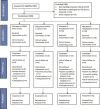Feasibility and acceptability of the HOLObalance telerehabilitation system compared with standard care for older adults at risk of falls: the HOLOBalance assessor blinded pilot randomised controlled study
- PMID: 39373575
- PMCID: PMC11457341
- DOI: 10.1093/ageing/afae214
Feasibility and acceptability of the HOLObalance telerehabilitation system compared with standard care for older adults at risk of falls: the HOLOBalance assessor blinded pilot randomised controlled study
Abstract
Background: Falls have high socioeconomic costs. Information and communication technologies may support provision and monitoring of multisensory (MSR) physiotherapy programmes. The HOLOBalance platform used augmented reality holograms to provide patient-centred, individualised MSR.
Objectives: To determine the platform's safety, acceptability and feasibility, investigate functional gait and dynamic balance benefits and provide data for a definitive trial.
Design and setting: Single-blinded pilot randomised controlled feasibility study. Interventions were conducted at clinical sites or participants' homes in three European countries.
Participants: Community-dwelling older adults (median age 73 years; 64.2% female) at risk of falls were enrolled (May 2020-August 2021).
Methods: Participants were randomised to an 8-week clinic or home-based telerehabilitation MSR or OTAGO (control group) programme. Compliance, satisfaction, and adverse events determined feasibility. Clinical outcomes, assessed (blinded) within one-week prior to and post-intervention, included functional gait assessment (FGA), Mini BESTest and cognitive function.
Results: Randomisation to completion rate was 76.15% with 109 participants recruited (n = 289 screened). Drop-out rate was similar between groups. Adverse events were reported (n = 3) in the control group. Sixty-nine percent would recommend the HOLOBalance intervention. Findings were similar for the home and clinic-based arms of each intervention; data was combined for analysis. FGA (95%CI [1.63, 4.19]) and Mini-BESTest (95%CI [1.46, 3.93]) showed greater improvement in the HOLOBalance group with a clinically meaningful change of 4/30 noted for the FGA.
Conclusions: HOLObalance was feasible to implement and acceptable to older adults at risk of falls, with FGA and Mini-BEST improvements exceeding those for the OTAGO programme. A definitive trial is warranted.
Keywords: augmented reality; balance rehabilitation; falls risk; older adults; older people.
© The Author(s) 2024. Published by Oxford University Press on behalf of the British Geriatrics Society.
Conflict of interest statement
None declared.
Figures


References
-
- Lord SR, Sherrington C, Menz Het al. . Falls in Older People: Risk Factors and Strategies for Prevention. 2nd edition. Cambridge University Press, Cambridge, England, 2007. 10.1017/CBO9780511722233. - DOI
-
- Liston MB, Bamiou DE, Martin Fet al. . Peripheral vestibular dysfunction is prevalent in older adults experiencing multiple non-syncopal falls versus age-matched non-fallers: a pilot study. Age Ageing. 2014;43:38–43. - PubMed
-
- Baldursdottir B, Petersen H, Jonsson PVet al. . Sensory impairments and wrist fractures: a case-control study. J Rehabil Med. 2018;50:209–15. - PubMed
Publication types
MeSH terms
Grants and funding
LinkOut - more resources
Full Text Sources
Medical
Miscellaneous

